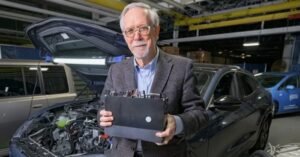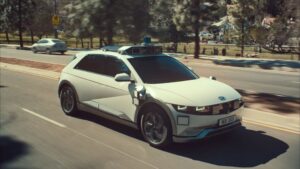EV ‘range anxiety’ may be misplaced, survey finds
A motorist’s fear that their EV may not have the range to get them where they want to go, along with the high cost of the longest-range vehicles is often cited as a primary cause for their reluctance to switch to electric vehicles. There’s even a Wikipedia page on the subject.
A new study, led by University of Delaware researchers with collaborators at Dalhousie University and Georgia Tech however, suggests that such anxiety tends to be misplaced and cheaper vehicle are often perfectly suitable to people’s needs.

Willett Kempton holds an EV battery module in his research lab at UD’s Science, Technology and Advanced Research Campus
The team analysed data from 333 petrol driven cars over a period of between one and three years then examined how those driving patterns could have been handled by EV vehicles of various battery sizes and recharging power.
Prof. Willett Kempton said ‘What we did was figure out how much people drive a year, distinguishing every single trip and stop, and then overlaid that with all the possible EVs you could buy. If you know how far you need to drive, our data on range and charging speed will tell you what EVs will work for you.’
Contrary to the perception that the future of widespread EV adoption is entwined with the development of larger batteries with greater range, the research concluded that for around 30% of the driving population, EVs with smaller batteries – along with community charging – are more than enough for their needs.
‘If you add up the categories, these people need no more than a moderate-size battery vehicle,’ Kempton said. ‘And that EV with a smaller battery that’s right for them will cost a lot less — up to $10,000 less — than an EV with a big battery.’
The team’s research showed that a 150-mile vehicle would meet the majority of drivers’ needs if they are willing to make adaptations to their driving and recharging plans for longer-distance trips a couple of times a year.
The professor concluded: ‘Solving the driving range problem is interesting because it’s not just that automakers have to make these EVs available, it’s also the public sector that needs to have public charging thoughtfully located to enable this kind of smaller-battery, lower-cost EV,’
As we recently reported, more funds have been released in England to provide 2,600 more EV chargepoints.
Image: University of Delaware/ Evan Krape














